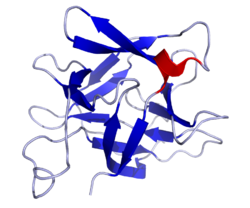
Interleukin 18

1J0S, 2VXT, 3F62, 4EEE, 4EKX, 4HJJ, 3WO2, 3WO3, 3WO4, 4R6U, 4XFS, 4XFT, 4XFU360616173ENSG00000150782ENSMUSG00000039217Q14116P70380NM_001243211NM_001562NM_008360NM_001357221NM_001357222NP_001230140NP_001553NP_001230140.1NP_032386NP_001344150NP_001344151Interleukin-18 (IL18, also known as interferon-gamma inducing factor) is a protein which in humans is encoded by the IL18 gene. The protein encoded by this gene is a proinflammatory cytokine. This cytokine is produced by many immune cells and can modulate both innate and adaptive immunity and dysregulation can cause autoimmune or inflammatory diseases. IL-18 was first time described in 1989. It is synthesized as an inactive 24kDa propeptide which is activated by proteolytic cleavage by caspase-1 in the NLRP3 inflammasome which generate biologically functional 18kDa molecule. IL-18 binds to IL-18 receptor which is composed of the inducible component IL-18Rα and the constitutively expressed part IL-18Rβ and than it activate IL-1 pathway. The activity of IL-18 can be suppressed by interleukin 18 binding protein which prevents IL-18 binding to its receptor. 1j0s: Solution structure of the human interleukin-18 Interleukin-18 (IL18, also known as interferon-gamma inducing factor) is a protein which in humans is encoded by the IL18 gene. The protein encoded by this gene is a proinflammatory cytokine. This cytokine is produced by many immune cells and can modulate both innate and adaptive immunity and dysregulation can cause autoimmune or inflammatory diseases. IL-18 was first time described in 1989. It is synthesized as an inactive 24kDa propeptide which is activated by proteolytic cleavage by caspase-1 in the NLRP3 inflammasome which generate biologically functional 18kDa molecule. IL-18 binds to IL-18 receptor which is composed of the inducible component IL-18Rα and the constitutively expressed part IL-18Rβ and than it activate IL-1 pathway. The activity of IL-18 can be suppressed by interleukin 18 binding protein which prevents IL-18 binding to its receptor. IL-18 is a cytokine that belongs to the IL-1 superfamily and is produced by macrophages and other cells. IL-18 works by binding to the interleukin-18 receptor, and together with IL-12, it induces cell-mediated immunity following infection with microbial products like lipopolysaccharide (LPS). After stimulation with IL-18 in presence of IL-12, natural killer (NK) cells and certain T cells release another important cytokine called interferon-γ (IFN-γ) or type II interferon that plays an important role in activating the macrophages or other cells. The combination of this cytokine and IL12 has been shown to inhibit IL-4 dependent IgE and IgG1 production and enhance IgG2a production in B cells. IL-18 binding protein (IL18BP) can specifically interact with this cytokine and thus negatively regulate its biological activity. Apart from its physiological role, IL-18 is also able to induce severe inflammatory reactions, which suggests its role in certain inflammatory disorders. Endometrial IL-18 receptor mRNA and the ratio of IL-18 binding protein to interleukin 18 are significantly increased in adenomyosis patients in comparison to normal people, indicating a role in its pathogenesis. IL-18 has been implicated as an inflammatory mediator of Hashimoto's thyroiditis, the most common cause of autoimmune hypothyroidism. IL-18 is up regulated by interferon-gamma. IL-18 has also been found to increase the Alzheimer's disease-associated amyloid-beta production in human neuron cells. IL-18 is also associated with urine protein excretion what means that it can be marker for assessing the progression of diabetic nephropathy. This interleukin was also significantly elevated in patients with microalbuminuria and macroalbuminuria when it was compared with healthy people and patients with diabetes which have normoalbuminuria.
